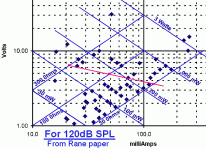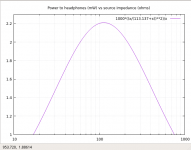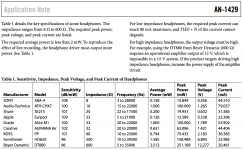old spreadsheet from a head-fi contributor (xls?, I saved as open office spreadsheet, had to add .txt to post here)
headphone sensitivities have been referenced to different levels - dB mW, and increasingly dB for 1 Vrms input (especially iem)
"tech spec" copywriters seem clueless, most don't show ref level, just quote 'dB'
Tyll Hertsens more modern headphonew measurements can be found at Headphone Measurements | InnerFidelity
headphone sensitivities have been referenced to different levels - dB mW, and increasingly dB for 1 Vrms input (especially iem)
"tech spec" copywriters seem clueless, most don't show ref level, just quote 'dB'
Tyll Hertsens more modern headphonew measurements can be found at Headphone Measurements | InnerFidelity
Attachments
Last edited:
What would make the spreadsheet even nicer is having the specs for a couple hundred models, you click on it and it tells you voltage/current/power for, say, 110dB.
Some headphones (in particular, Sony MDR-7506) have some bad resonances if they're not driven from a very low impedance (much less than 8 ohms). The 330 ohm series resistors in older stereos is a big problem for this. I discovered this a couple decades ago, LP clicks sounded like a cowbell, but a "proper" L-pad with the output resistor in the range of 1 ohm made a world of difference. Scale the input resistor per below:
Among all the rest, I'd also want to know the peak output voltage of the amplifier. This way I can make a low-impedance L pad that gives a peak volume of, say, 110dBSPL (or the loudest peak I'd ever want to hear) in the headphones, as opposed to connecting up and discovering the hard way that the peak volume is 130dBSPL. The headphones may not go that loud, but they'll try and I'd rather not be wearing them if that much power input to them is possible.
Also, an L-pad will lower the amplifier's noise floor as heard in the headphones, yet another reason to use one.
Some headphones (in particular, Sony MDR-7506) have some bad resonances if they're not driven from a very low impedance (much less than 8 ohms). The 330 ohm series resistors in older stereos is a big problem for this. I discovered this a couple decades ago, LP clicks sounded like a cowbell, but a "proper" L-pad with the output resistor in the range of 1 ohm made a world of difference. Scale the input resistor per below:
Among all the rest, I'd also want to know the peak output voltage of the amplifier. This way I can make a low-impedance L pad that gives a peak volume of, say, 110dBSPL (or the loudest peak I'd ever want to hear) in the headphones, as opposed to connecting up and discovering the hard way that the peak volume is 130dBSPL. The headphones may not go that loud, but they'll try and I'd rather not be wearing them if that much power input to them is possible.
Also, an L-pad will lower the amplifier's noise floor as heard in the headphones, yet another reason to use one.
Last edited:
...many different headphone impedances, from 32 ohms to 600 ohms, ...What sort of signal levels do these things want to make your ears bleed? I see numbers of xx mW but I guess it depends a lot on the headphone impedance....
Power efficiency varies but not too much. Obviously the voltage (or current) for a specified acoustic level depends on the impedance.
Some years back, as part of my job, I needed an amp to get LOUD for any reasonable headphone which fell into my gig-bag. I needed to know that any clipping was in the system being monitored, not the headphone amp.
RANE had data. I plotted them on I-V-Z-P scales.
120dB SPL is VERY FRIKKIN LOUD. I would approach that for seconds, not minutes. (Even so I have lost much hearing, though more from other factors.)
Electric power for 120dB SPL can be <30mW or >3,000mW. This is not very different than speakers which can be 30% or 0.3% efficient.
Combined with a 10:1 range of impedance, you may want 1V 25mA or 15V 250mA.
There is NO "universal answer". Except that at headphone powers, gross overkill is affordable. Like if Toyota sold a 3,000 horsepower blown nitro hemi for an extra $30.
A "good fit answer" for 120dB SPL seems to be 7Vrms behind 29 Ohms. Pink Line. It will put 6V 120mW in 300 Ohms, 3.6V 420mW in 32 Ohms. As the 300r cans derive from good studio practice, and the 32r market is not so high strung, the higher power in the lower Z gives more-equal output in different impedances.
I repeat: 120dB SPL is VERY FRIKKIN LOUD. I was getting paid well, and very conscious that deafness was bad for my career. I do not think anybody should risk 120dB SPL "for fun". I assure you that deaf is NOT fun.
For non-paid non-professional work, I would aim 10dB lower. 2.2Vrms behind 29 Ohms.
If you "need" more than that, PLEASE get tested. In the US you can find an audiologist to give a free screening exam. It may be more routine in places with respectful healthcare.
Attachments
I measured drive levels some years ago for my Sony cans:
Some actual performance results and thoughts etc.
How much drive is needed... well with music on the Sony cans around 0.8 volts peak/peak (transients) is more than enough for me. Average is around 0.2 to 0.4 volts.
How much output can it deliver... around 4.5 volts peak/peak using the Sonys as a load before clipping using the 6.8 volt supply.
The response is 3db down at 46khz ... that's power calculated into the load.
There is also a small table in here, not as extensive as many others, but I always use that for reference together with the headphones I actually own and some exotic ones with lower efficiency.
https://www.analog.com/media/en/technical-documentation/application-notes/AN-1429.pdf
Not that you directly asked for it, but on Page 17 of the PDF corresponding to the reference design is a nice high frequency impedance approximation for loop stability analysis with lower impedance headphones. At least for me it's nice for lack of proper alternatives. Maybe someone has a better approximation, I don't know.
https://www.analog.com/media/en/technical-documentation/application-notes/AN-1429.pdf
Not that you directly asked for it, but on Page 17 of the PDF corresponding to the reference design is a nice high frequency impedance approximation for loop stability analysis with lower impedance headphones. At least for me it's nice for lack of proper alternatives. Maybe someone has a better approximation, I don't know.
I found data I collected in 2002.
> calculation to determine voltage requirements for your headphones.
How much voltage?
Depends on headphone power sensitivity, impedance, and desired listening level, of course.
On HeadRoom's site, they propose a level of 100 dB SPL as a guide, and publish the voltage needed to reach this level for the headphones they sell. 100 dB SPL is perhaps arbitrary: we know many people listen in the mid-80s, and others need more than 100 dB SPL. However, 100 is enough for most folks, and those who need more can do the math for their level.
Sadly, something in HeadRoom's webserver is busted: all the values are "0.0V". So I computed numbers from Rane's paper posted on HeadWise.
Conclusion? If 100dB SPL is your goal, any headphone on this list (or similar) will reach that level with 3 Volts and 26 mA RMS (4.2V 40mA Peak). This is within reach of small chips working on 9V batteries.
If 100 dB SPL is not enough, you probably want to look for 110 dB SPL. Triple the numbers above (3^2=10, near enuff). 10 volts and 80 mA may be needed.
-PRR
> calculation to determine voltage requirements for your headphones.
How much voltage?
Depends on headphone power sensitivity, impedance, and desired listening level, of course.
On HeadRoom's site, they propose a level of 100 dB SPL as a guide, and publish the voltage needed to reach this level for the headphones they sell. 100 dB SPL is perhaps arbitrary: we know many people listen in the mid-80s, and others need more than 100 dB SPL. However, 100 is enough for most folks, and those who need more can do the math for their level.
Sadly, something in HeadRoom's webserver is busted: all the values are "0.0V". So I computed numbers from Rane's paper posted on HeadWise.
Code:
___for_100dB_SPL___
Man, Model Imped. Sens. mW Volt mA
AKG- K141M 600 98 1.6 0.98 1.6
K240M;K240DF 600 88 15.8 3.08 5.1
K270S 75 92 6.3 0.69 9.2
K301 100 94 4.0 0.63 6.3
K401;K501 120 94 4.0 0.69 5.8
AT- COM1;COM2;908 40 90 10.0 0.63 15.8
ATH-910 40 92 6.3 0.50 12.6
ATH-P5 40 100 1.0 0.20 5.0
ATH-M40 60 100 1.0 0.24 4.1
ATH-D40 66 102 0.6 0.20 3.1
ATH-M2X;ATH-M3X 45 100 1.0 0.21 4.7
DT150 250 97 2.0 0.71 2.8
DT211;DT311 40 98 1.6 0.25 6.3
DT250 80 98 1.6 0.36 4.5
DT411 250 102 0.6 0.40 1.6
DT531 250 95 3.2 0.89 3.6
DT431;DT331 40 86 25.1 1.00 25.1
DT770PRO;DT990PRO 600 96 2.5 1.23 2.0
DT801;DT811,DT511 250 94 4.0 1.00 4.0
DT901;DT911 250 98 1.6 0.63 2.5
Fostex- T-5 44 96 2.5 0.33 7.6
T-7 70 98 1.6 0.33 4.8
T-20 50 96 2.5 0.35 7.1
T-40 50 98 1.6 0.28 5.6
Hosa- HDS-701 40 91 7.9 0.56 14.1
KOSS- A250;A200;A130;TD80 60 98 1.6 0.31 5.1
R/200 60 84 39.8 1.55 25.8
R/100;R/45 60 85 31.6 1.38 23.0
R/90;HD/2;SB/15 60 100 1.0 0.24 4.1
R/80;R/35S;R/20;PortaPro 60 101 0.8 0.22 3.6
R/70B;R/55B;SB/50;SB/35 60 101 0.8 0.22 3.6
R/40 60 90 10.0 0.77 12.9
R/30S 60 106 0.3 0.12 2.0
R/10 60 103 0.5 0.17 2.9
TD/75 60 95 3.2 0.44 7.3
TD/65 90 101 0.8 0.27 3.0
TD/61 38 93 5.0 0.44 11.5
Sennheiser- HD433;HD435 32 94 4.0 0.36 11.2
HD25 70 102 0.6 0.21 3.0
HD445 52 97 2.0 0.32 6.2
HD25SP 85 100 1.0 0.29 3.4
HD265;525;535;545;565 150 94 4.0 0.77 5.2
HD455;HD475 60 94 4.0 0.49 8.1
HD465 100 94 4.0 0.63 6.3
HD580;HD600 300 97 2.0 0.77 2.6
Sony- MDR-V100MK2 32 98 1.6 0.23 7.0
MDR-85 40 102 0.6 0.16 4.0
MDR-V600;MDR-D77 45 106 0.3 0.11 2.4
MDR-CD10 32 96 2.5 0.28 8.9
MDR-CD550;CD750 45 100 1.0 0.21 4.7
MDR-CD6 45 110 0.1 0.07 1.5
MDR-CD850;CD950 32 102 0.6 0.14 4.4
MDR-CD1000;CD3000 32 104 0.4 0.11 3.5
MDR-D33;MDR-D55;MDR-7504 45 104 0.4 0.13 3.0
MDR-7506 63 106 0.3 0.13 2.0
MDR-7502 45 102 0.6 0.17 3.7
Stanton- ST;DJ;-1000 32 100 1.0 0.18 5.6
Telex- PH-6 600 105 0.3 0.44 0.7
Yamaha -RH5M 32 98 1.6 0.23 7.0
RH1 32 90 10.0 0.57 17.7
RH2 32 95 3.2 0.32 9.9
RH3 60 95 3.2 0.44 7.3
RH10M 40 102 0.6 0.16 4.0
RH40M 32 103 0.5 0.13 4.0
Max (all models) 39.8 3.08 25.76
Avg (all models) 4.0 0.48 6.51If 100 dB SPL is not enough, you probably want to look for 110 dB SPL. Triple the numbers above (3^2=10, near enuff). 10 volts and 80 mA may be needed.
-PRR
On another thread in another sub-forum, there was a similar discussion about trying to keep your hearing intact while wearing headphones, and the additional difficulties posed by varying headphone impedances. PRR told me about this thread, and I thought I might have something useful to contribute, so here I am.I see a switch in my future, labelled 'hi-imp' and 'low-imp', to at least separate them in two groups and keeping the volume settings manageable.
Thinking about this problem on that other thread, I came to a possibly useful realization: when driven by a voltage source, more power is fed to lower-impedance headphones. When driven by a current source, more power is fed to higher-impedance headphones.
This suggests that there is an optimum source impedance that will deliver exactly the same power to two different specified headphone impedances, with no other change. I did the algebra, and found that this is indeed the case.
(In more technical terms, if you write down the equation for power delivered to two different headphone impedances, and set those two powers to be equal, you get a quadratic equation in headphone impedance. In general the equation has two different real roots, i.e., two different headphone impedances that will receive the same amount of power.)
I plugged 32 ohms and 400 ohms into my equation, the first commonly found in consumer headphones, the second apparently frequently found in recording studios. The optimum source impedance then turns out to be 113.137 ohms: a headphone amplifier with that output impedance delivers exactly the same power to 32 ohm or 400 ohm headphones, all else being unchanged.
No need to be that picky, of course; a source impedance of 110 ohms is more than close enough.
For the attached image: the x-axis is headphone impedance in ohms, the y-axis is power delivered in milliwatts, for a no-load source voltage of 1 volt RMS, and a source impedance of 113.137 ohms.
Note that x=32 and x=400 both receive the same 1.5 mW of power.
Any headphone between 32 ohms and 400 ohms will be safe to use; power only goes up from 1.5 mW to 2.2 mW at the loudest headphone impedance (which, of course, is also 113.13708 ohms, as per the maximum power transfer equation.) This is only a 0.7 dB increase, which is negligible as far as ear safety goes.
In fact, for any headphone impedance between 10 ohms and 1000 ohms, power delivered varies by no more than about 2 dB.
This leaves headphone sensitivity as the major remaining variable. If one pair of 'phones produces 95 dB@1mW, and the other 110 dB@1mW, you're still in trouble.
Downsides? The obvious one is that bass response of headphones depends on source impedance, and there is no guarantee that a 113 ohm source impedance will produce an optimal frequency response from your headphones. (But at least you're more likely to retain your hearing.)
-Gnobuddy
Attachments
There is also a small table in here, not as extensive as many others, but I always use that for reference together with the headphones I actually own and some exotic ones with lower efficiency.
Attachments
Referencing the 120 Ohm source impedance in IEC 61938, from Rod Elliot's amplifier to headphone adapter project:
Project 100
"This simple project is nothing more than a handful of resistors and a double pole, double throw switch, but will reduce the output of almost any amplifier to a nominal level of 5V RMS, and maintains the recommended 120Ω source impedance (IEC 61938). This is designed to suit most headphones currently made, as they are generally designed to operate from that impedance. "
Project 100
"This simple project is nothing more than a handful of resistors and a double pole, double throw switch, but will reduce the output of almost any amplifier to a nominal level of 5V RMS, and maintains the recommended 120Ω source impedance (IEC 61938). This is designed to suit most headphones currently made, as they are generally designed to operate from that impedance. "
So the impedance that delivers constant power to 32 ohm or 400 ohm 'phones also happens to be quite close to the IEC standard. That's a fortunate coincidence!...recommended 120Ω source impedance (IEC 61938)...
-Gnobuddy
If only headphones manufacturers took notice of it... Iirc, Beyerdynamic is about the only manufacturer to kind of follow that standard. Most others assume an output impedance nearer to zero when designing their headphones. And considering the sources in the real life are indeed not likely to be 120R, who can blame them ?
Sennheiser in particular has headphones with huge impedance bumps at about 100hz. Some of these have a nominal impedance of 64r or 150r. They turn to mud with a 120r output impedance.
Sennheiser in particular has headphones with huge impedance bumps at about 100hz. Some of these have a nominal impedance of 64r or 150r. They turn to mud with a 120r output impedance.
My neighbour's cow weighs 1355 lbs; my wife weighs 135.5 lbs. Exactly one-tenth as much as the cow! A suspicious coincidence! Perhaps the cow is really ten women disguised in a cow-suit?A suspicious coincidence.
More seriously, if the IEC standard had been 113.137 ohms, I would agree without question.
As things are, I need to see some actual facts before I believe there is any deeper significance than mere coincidence at work. A whitepaper describing the behind-the-scenes decisions that led to the IEC headphone source impedance standard, for example, or any official IEC documentation that says they chose a non-zero source impedance for headphone amplifiers in order to flatten SPL variations with changing headphone impedance.
-Gnobuddy
Of headphones?The large-signal and small-signal impedances can be quite different.
-Gnobuddy
Of amps. If you put a resistor at the output but inside the feedback loop, you can limit the power delivered to safe levels for a wide range of headphones. It doesn't help the gain situation obviously.Of headphones?
- Status
- This old topic is closed. If you want to reopen this topic, contact a moderator using the "Report Post" button.
- Home
- Amplifiers
- Headphone Systems
- Drive level for headphone?


